clock Seat Altea Freetrack 2008 Owner's Manual
[x] Cancel search | Manufacturer: SEAT, Model Year: 2008, Model line: Altea Freetrack, Model: Seat Altea Freetrack 2008Pages: 317, PDF Size: 9.56 MB
Page 13 of 317
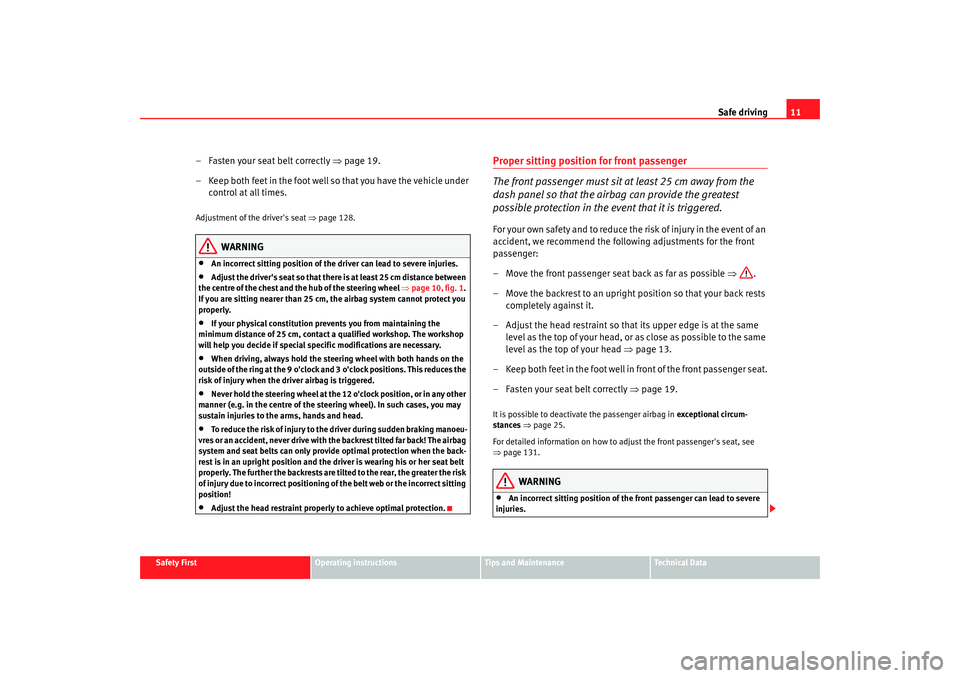
Safe driving11
Safety First
Operating instructions
Tips and Maintenance
Te c h n i c a l D a t a
–Fasten your seat belt correctly ⇒page 19.
– Keep both feet in the foot well so that you have the vehicle under control at all times.Adjustment of the driver's seat ⇒page 128.
WARNING
•
An incorrect sitting position of the driver can lead to severe injuries.
•
Adjust the driver's seat so that ther e is at least 25 cm distance between
the centre of the chest and the hub of the steering wheel ⇒page 10, fig. 1 .
If you are sitting nearer than 25 cm, the airbag system cannot protect you
properly.
•
If your physical constitution prevents you from maintaining the
minimum distance of 25 cm, contact a qualified workshop. The workshop
will help you decide if special specific modifications are necessary.
•
When driving, always hold the steering wheel with both hands on the
outside of the ring at the 9 o'clock and 3 o'clock positions. This reduces the
risk of injury when the driver airbag is triggered.
•
Never hold the steering wheel at the 12 o'clock position, or in any other
manner (e.g. in the centre of the steering wheel). In such cases, you may
sustain injuries to the arms, hands and head.
•
To reduce the risk of injury to the driver during sudden braking manoeu-
vres or an accident, never drive with the backrest tilted far back! The airbag
system and seat belts can only provide optimal protection when the back-
rest is in an upright position and the driver is wearing his or her seat belt
properly. The further the backrests are ti lted to the rear, the greater the risk
of injury due to incorrect positioning of the belt web or the incorrect sitting
position!
•
Adjust the head restraint properly to achieve optimal protection.
Proper sitting position for front passenger
The front passenger must sit at least 25 cm away from the
dash panel so that the airbag can provide the greatest
possible protection in the event that it is triggered.For your own safety and to reduce the risk of injury in the event of an
accident, we recommend the following adjustments for the front
passenger:
– Move the front passenger seat back as far as possible ⇒ .
– Move the backrest to an upright position so that your back rests completely against it.
– Adjust the head restraint so that its upper edge is at the same level as the top of your head, or as close as possible to the same
level as the top of your head ⇒page 13.
– Keep both feet in the foot well in front of the front passenger seat.
– Fasten your seat belt correctly ⇒page 19.It is possible to deactivate the passenger airbag in exceptional circum-
stances ⇒ page 25.
For detailed information on how to adjust the front passenger's seat, see
⇒ page 131.
WARNING
•
An incorrect sitting position of the front passenger can lead to severe
injuries.
altea_XL ingles.book Seite 11 Donnerstag, 13. September 2007 10:36 10
Page 60 of 317

Cockpit
58display
4). Stop the car and switch off the engine. Check the coolant level
⇒ page 223 ⇒.
Even if the coolant level is correct do not continue driving. You should obtain
technical assistance.WARNING
When working in the engine compartment, always bear in mind the safety
warnings ⇒ page 215.
Caution
Accessories in front of the air inlet reduce the cooling effect of the coolant. At
high outside temperatures and high engine loads, there is a risk of the
engine overheating.Rev counter
The rev. counter displays the engine speed in revolutions per
minute.The start of the red zone on the dial ⇒page 56, fig. 33 indicates the
maximum engine speed which may be used briefly when the engine is warm
and after it has been run in properly. However, it is advisable to change up a
gear or move the selector lever to D (or l ift your foot off the accelerator) before
the needle reaches the red zone.
Caution
The rev counter needle must never enter the red zone on the scale. Risk of
engine damage.
For the sake of the environment
Changing up a gear early will help you to save fuel and minimise engine
noise.Setting the digital clock*
The digital clock is located in the instrument panel display.– Turn the setting knob ⇒page 56, fig. 33 anti-clockwise to
the stop to set the hour. If the kn ob is turned briefly anti-clock-
wise the clock will advance one hour further.
– Turn the setting knob clockwise to the limit stop to set the minutes. If the knob is turned briefly clockwise the clock will
advance one minute further.
4)Depending on the model version
A4
A5
altea_XL ingles.book Seite 58 Donnerstag, 13. September 2007 10:36 10
Page 61 of 317
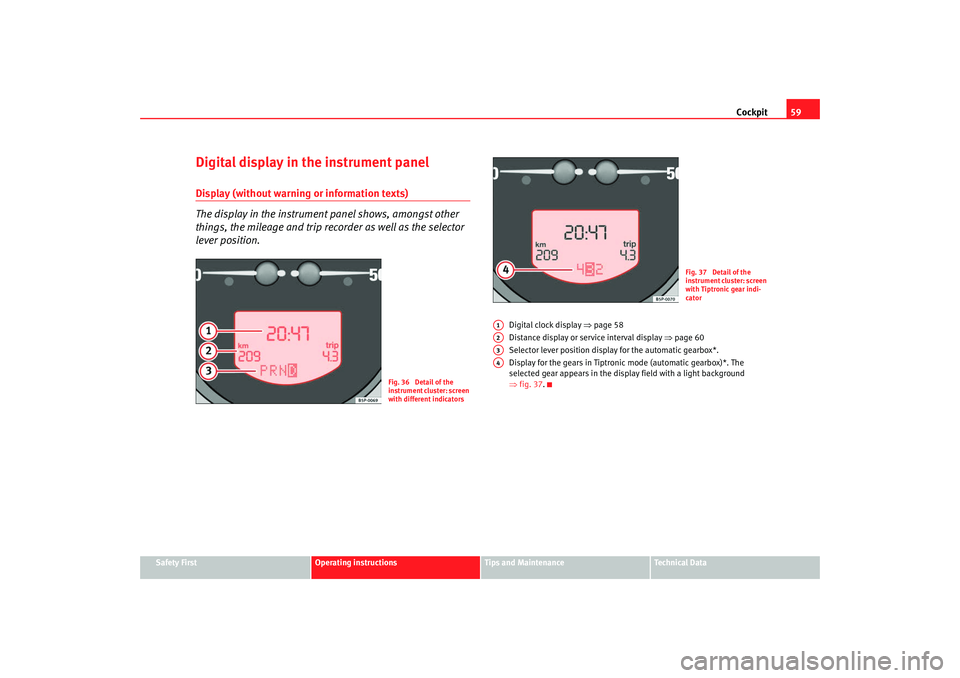
Cockpit59
Safety First
Operating instructions
Tips and Maintenance
Te c h n i c a l D a t a
Digital display in the instrument panelDisplay (without warning or information texts)
The display in the instrument panel shows, amongst other
things, the mileage and trip recorder as well as the selector
lever position.
Digital clock display ⇒page 58
Distance display or service interval display ⇒page 60
Selector lever position display for the automatic gearbox*.
Display for the gears in Tiptronic mode (automatic gearbox)*. The
selected gear appears in the display field with a light background
⇒ fig. 37 .
Fig. 36 Detail of the
instrument cluster: screen
with different indicators
Fig. 37 Detail of the
instrument cluster: screen
with Tiptronic gear indi-
cator
A1A2A3A4
altea_XL ingles.book Seite 59 Donnerstag, 13. September 2007 10:36 10
Page 62 of 317
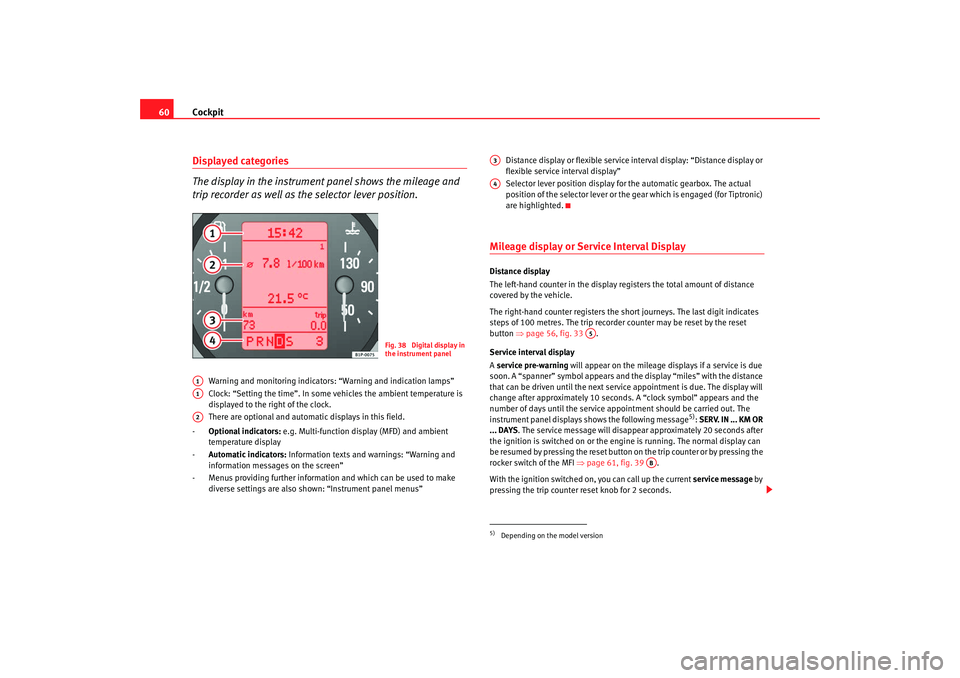
Cockpit
60Displayed categories
The display in the instrument panel shows the mileage and
trip recorder as well as the selector lever position.
Warning and monitoring indicators: “Warning and indication lamps”
Clock: “Setting the time”. In some vehicles the ambient temperature is
displayed to the right of the clock.
There are optional and automatic displays in this field.
- Optional indicators: e.g. Multi-function display (MFD) and ambient
temperature display
- Automatic indicators: Information texts and warnings: “Warning and
information messages on the screen”
- Menus providing further information and which can be used to make diverse settings are also shown: “Instrument panel menus” Distance display or flexible service interval display: “Distance display or
flexible service interval display”
Selector lever position display for the automatic gearbox. The actual
position of the selector lever or the gear which is engaged (for Tiptronic)
are highlighted.
Mileage display or Service Interval DisplayDistance display
The left-hand counter in the display registers the total amount of distance
covered by the vehicle.
The right-hand counter regi
sters the short journeys. The last digit indicates
steps of 100 metres. The trip recorder counter may be reset by the reset
button ⇒page 56, fig. 33 .
Service interval display
A service pre-warning will appear on the mileage displays if a service is due
soon. A “spanner” symbol appears and the display “miles” with the distance
that can be driven until the next service appointment is due. The display will
change after approximately 10 seconds. A “clock symbol” appears and the
number of days until the service appointment should be carried out. The
instrument panel displays shows the following message
5): SERV. IN ... KM OR
... DAYS . The service message will disappear approximately 20 seconds after
the ignition is switched on or the en gine is running. The normal display can
be resumed by pressing the reset button on the trip counter or by pressing the
rocker switch of the MFI ⇒page 61, fig. 39 .
With the ignition switched on, you can call up the current service message by
pressing the trip counter reset knob for 2 seconds.
Fig. 38 Digital display in
the instrument panel
A1A1A2
5)Depending on the model versionA3A4
A5
AB
altea_XL ingles.book Seite 60 Donnerstag, 13. September 2007 10:36 10
Page 71 of 317
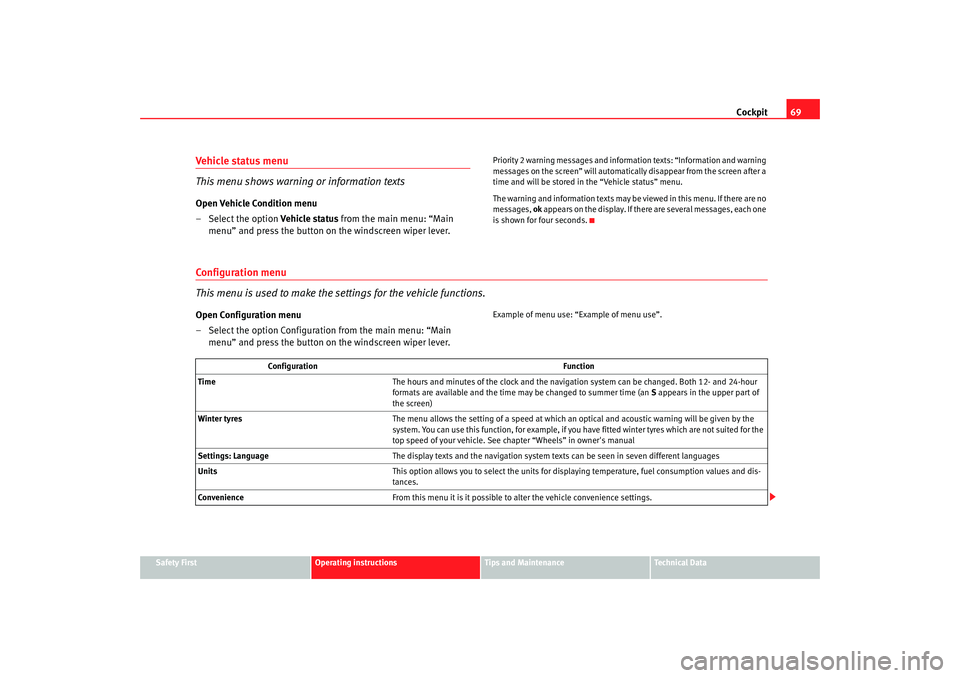
Cockpit69
Safety First
Operating instructions
Tips and Maintenance
Te c h n i c a l D a t a
Vehicle status menu
This menu shows warning or information textsOpen Vehicle Condition menu
– Select the option Vehicle status from the main menu: “Main
menu” and press the button on the windscreen wiper lever.
Priority 2 warning messages and informat ion texts: “Information and warning
messages on the screen” will automatically disappear from the screen after a
time and will be stored in the “Vehicle status” menu.
The warning and information texts may be viewed in this menu. If there are no
messages, ok appears on the display. If there are several messages, each one
is shown for four seconds.
Configuration menu
This menu is used to make the settings for the vehicle functions.Open Configuration menu
– Select the option Configuratio n from the main menu: “Main
menu” and press the button on the windscreen wiper lever.
Example of menu use: “Example of menu use”.
Configuration Function
Time The hours and minutes of the clock and the navigation system can be changed. Both 12- and 24-hour
formats are available and the time may be changed to summer time (an S appears in the upper part of
the screen)
Winter tyres The menu allows the setting of a speed at which an optical and acoustic warning will be given by the
system. You can use this function, for example, if you have fitted winter tyres which are not suited for the
top speed of your vehicle. See chapter “Wheels” in owner's manual
Settings: Language The display texts and the navigation system texts can be seen in seven different languages
Units This option allows you to select the units for displaying temperature, fuel consumption values and dis-
tances.
Convenience From this menu it is it possible to alter the vehicle convenience settings.
altea_XL ingles.book Seite 69 Donnerstag, 13. September 2007 10:36 10
Page 98 of 317
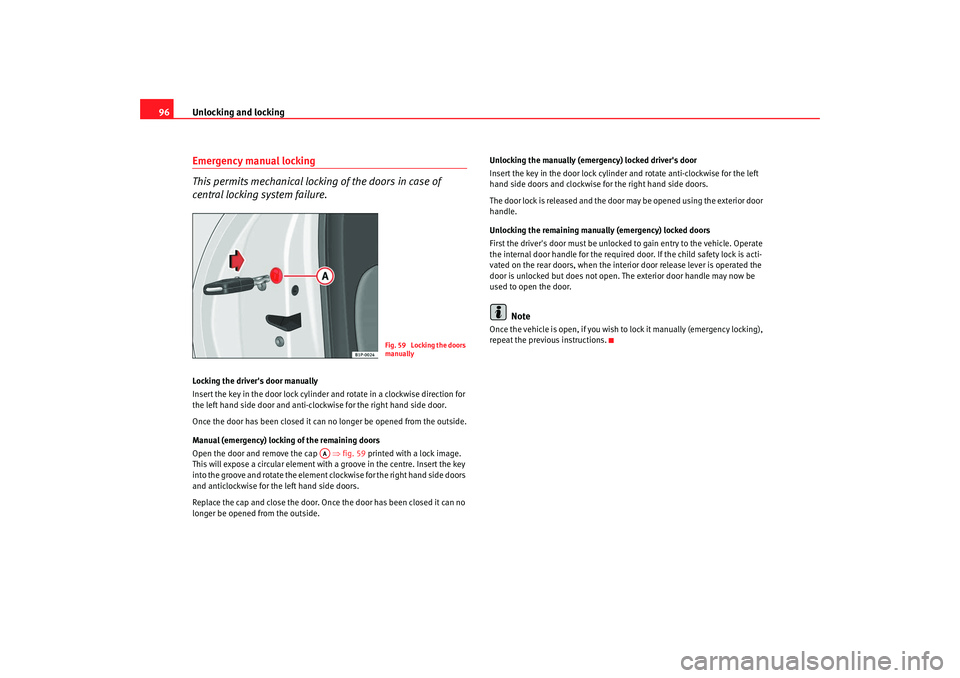
Unlocking and locking
96Emergency manual locking
This permits mechanical locking of the doors in case of
central locking system failure.Locking the driver's door manually
Insert the key in the door lock cylinder and rotate in a clockwise direction for
the left hand side door and anti-clockwise for the right hand side door.
Once the door has been closed it can no longer be opened from the outside.
Manual (emergency) locking of the remaining doors
Open the door and remove the cap ⇒fig. 59 printed with a lock image.
This will expose a circular element with a groove in the centre. Insert the key
into the groove and rotate the element clockwise for the right hand side doors
and anticlockwise for the left hand side doors.
Replace the cap and close the door. Once the door has been closed it can no
longer be opened from the outside. Unlocking the manually (emergency) locked driver's door
Insert the key in the door lock cylinder
and rotate anti-clockwise for the left
hand side doors and clockwise for the right hand side doors.
The door lock is released and the door may be opened using the exterior door
handle.
Unlocking the remaining manually (emergency) locked doors
First the driver's door must be unlocke d to gain entry to the vehicle. Operate
the internal door handle for the required door. If the child safety lock is acti-
vated on the rear doors, when the interior door release lever is operated the
door is unlocked but does not open. The exterior door handle may now be
used to open the door.
Note
Once the vehicle is open, if you wish to lock it manually (emergency locking),
repeat the previous instructions.
Fig. 59 Locking the doors
manually
AA
altea_XL ingles.book Seite 96 Donnerstag, 13. September 2007 10:36 10
Page 100 of 317
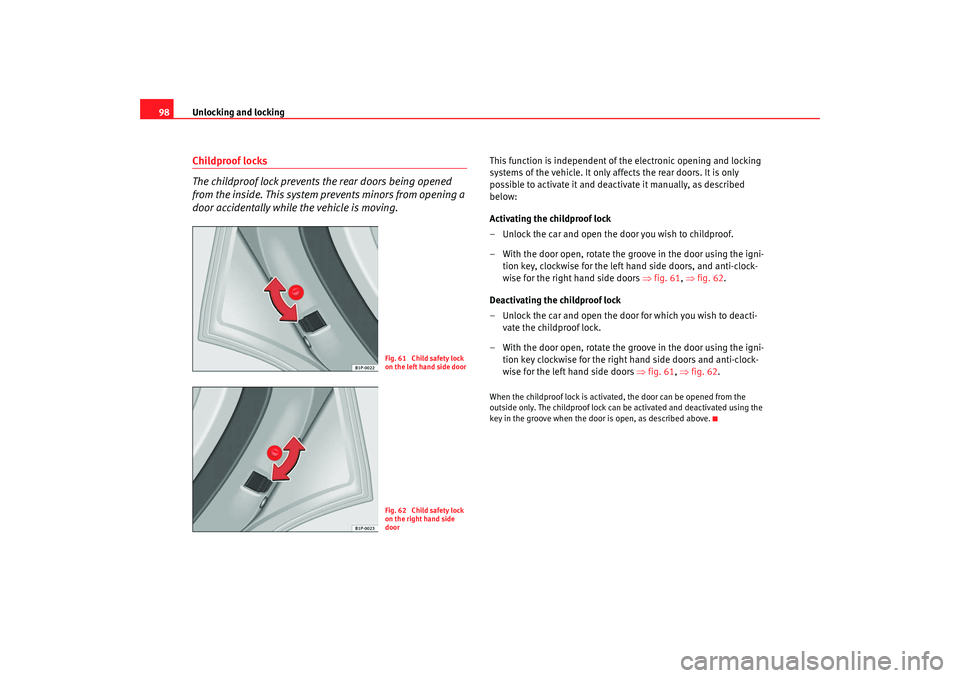
Unlocking and locking
98Childproof locks
The childproof lock prevents the rear doors being opened
from the inside. This system prevents minors from opening a
door accidentally while the vehicle is moving.
This function is independent of the electronic opening and locking
systems of the vehicle. It only affects the rear doors. It is only
possible to activate it and deactivate it manually, as described
below:
Activating the childproof lock
– Unlock the car and open the door you wish to childproof.
– With the door open, rotate the groove in the door using the igni-
tion key, clockwise for the left hand side doors, and anti-clock-
wise for the right hand side doors ⇒fig. 61 , ⇒ fig. 62.
Deactivating the childproof lock
– Unlock the car and open the door for which you wish to deacti- vate the childproof lock.
– With the door open, rotate the groove in the door using the igni- tion key clockwise for the right hand side doors and anti-clock-
wise for the left hand side doors ⇒fig. 61 , ⇒ fig. 62 .When the childproof lock is activate d, the door can be opened from the
outside only. The childproof lock can be activated and deactivated using the
key in the groove when the door is open, as described above.
Fig. 61 Child safety lock
on the left hand side doorFig. 62 Child safety lock
on the right hand side
door
altea_XL ingles.book Seite 98 Donnerstag, 13. September 2007 10:36 10
Page 156 of 317
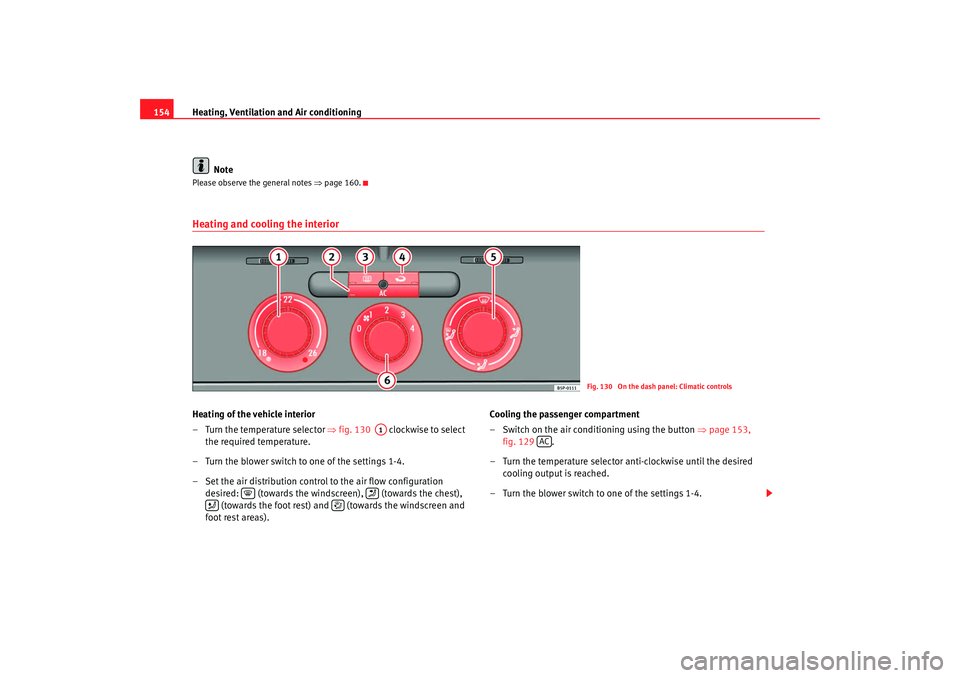
Heating, Ventilation and Air conditioning
154
NotePlease observe the general notes ⇒page 160.Heating and cooling the interiorHeating of the vehicle interior
– Turn the temperature selector ⇒fig. 130 clockwise to select
the required temperature.
– Turn the blower switch to one of the settings 1-4.
– Set the air distribution control to the air flow configuration desired: (towards the windsc reen), (towards the chest),
(towards the foot rest) and (towards the windscreen and
foot rest areas). Cooling the passenger compartment
– Switch on the air conditioning using the button
⇒page 153,
fig. 129 .
– Turn the temperature selector anti-clockwise until the desired cooling output is reached.
– Turn the blower switch to one of the settings 1-4.
Fig. 130 On the dash panel: Climatic controls
A1
AC
altea_XL ingles.book Seite 154 Donnerstag, 13. September 2007 10:36 10
Page 164 of 317
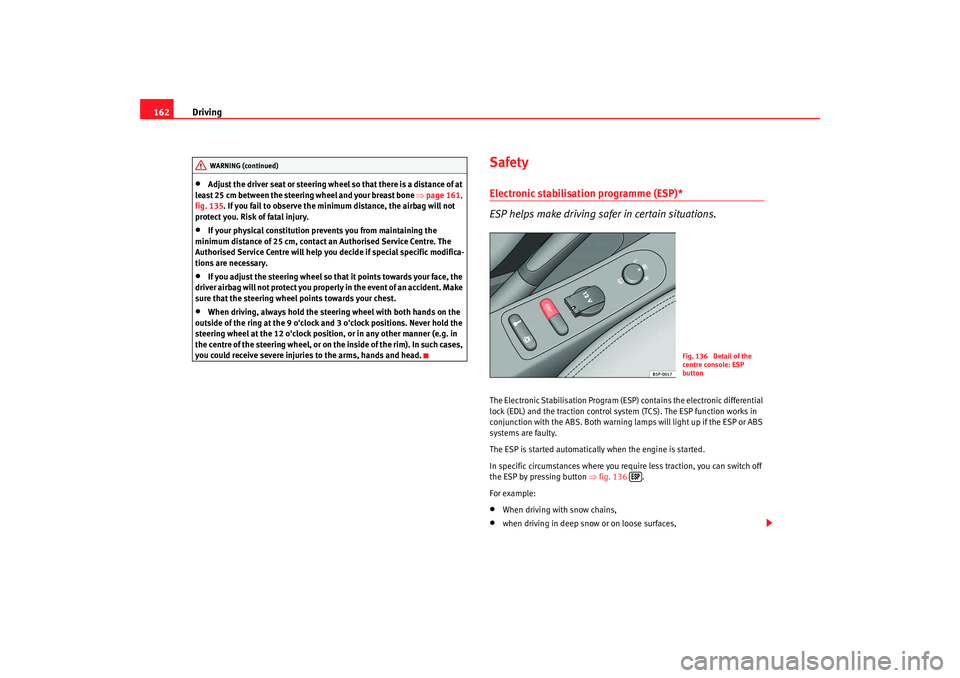
Driving
162•
Adjust the driver seat or steering wheel so that there is a distance of at
least 25 cm between the steering wheel and your breast bone ⇒page 161,
fig. 135. If you fail to observe the minimum distance, the airbag will not
protect you. Risk of fatal injury.
•
If your physical constitution prevents you from maintaining the
minimum distance of 25 cm, contact an Authorised Service Centre. The
Authorised Service Centre will help you decide if special specific modifica-
tions are necessary.
•
If you adjust the steering wheel so tha t it points towards your face, the
driver airbag will not protect you properly in the event of an accident. Make
sure that the steering wheel points towards your chest.
•
When driving, always hold the steer ing wheel with both hands on the
outside of the ring at the 9 o'clock and 3 o'clock positions. Never hold the
steering wheel at the 12 o'clock positi on, or in any other manner (e.g. in
the centre of the steering wheel, or on the inside of the rim). In such cases,
you could receive severe injuries to the arms, hands and head.
SafetyElectronic stabilisation programme (ESP)*
ESP helps make driving safer in certain situations.The Electronic Stabilisation Program (ESP ) contains the electronic differential
lock (EDL) and the traction control syst em (TCS). The ESP function works in
conjunction with the ABS. Both warning lamps will light up if the ESP or ABS
systems are faulty.
The ESP is started automatically when the engine is started.
In specific circumstances where you require less traction, you can switch off
the ESP by pressing button ⇒fig. 136 .
For example:•
When driving with snow chains,
•
when driving in deep snow or on loose surfaces,
WARNING (continued)
Fig. 136 Detail of the
centre console: ESP
button
altea_XL ingles.book Seite 162 Donnerstag, 13. September 2007 10:36 10
Page 214 of 317

Checking and refilling levels
212Checking and refilling levelsRefuellingThe tank flap is released manually. The tank holds approxi-
mately 55 litres. On vehicles with four-wheel drive, the fuel
tank has a capacity of approx. 60 litres.Unscrewing the tank cap
–Lift the lid.
– Grip the cap and then insert the key into the lock and rotate 180°
to the left.
– Unscrew the cap, turning it anti-clockwise. Closing the tank cap
– Screw the tank cap to the right, until the point of feeling a “click”.
– Turn the key in the lock, without releasing the cap in the clock-
wise direction 180°.
– Remove the key and close the flap until it clicks into place. The tank cap is secured with an anti-loss attachment
The tank flap is at the rear of the vehicle on the right.
If the automatic filler nozzle is operated correctly, it will switch itself off as
soon as the tank is “full”. Never attempt to fill beyond this point, as this will
fill the expansion chamber. Fuel may leak out if ambient conditions are warm.
The correct fuel grade for your vehicle is given on a sticker on the inside of the
fuel tank flap. Further notes on fuel can be found.
WARNING
•
Fuel is highly inflammable and can cause serious burns and other inju-
ries.
−Never smoke or use any naked flame when filling the fuel tank of the
vehicle, or a spare fuel canister, with fuel. This is an explosion hazard.
− Follow legal requirements for the use of spare fuel canisters.
− For safety reasons we do not recommend carrying a spare fuel
canister in the vehicle. The canister could be damaged in an accident
and leak.
•
If, in exceptional circumstances, you have to carry a spare fuel canister,
please observe the following points:
Fig. 161 Tank flap open
altea_XL ingles.book Seite 212 Donnerstag, 13. September 2007 10:36 10